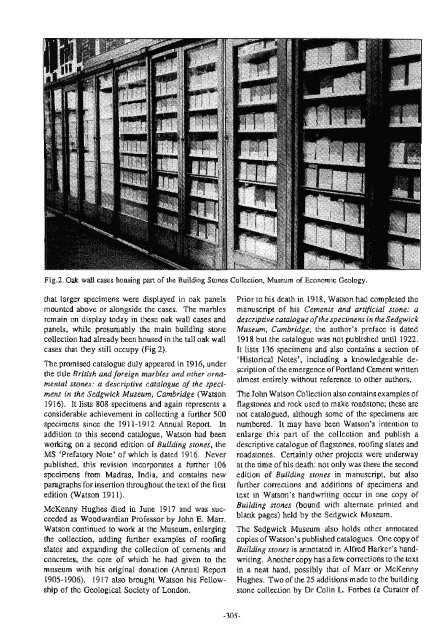Number 8 - Geological Curators Group
Number 8 - Geological Curators Group
Number 8 - Geological Curators Group
- No tags were found...
You also want an ePaper? Increase the reach of your titles
YUMPU automatically turns print PDFs into web optimized ePapers that Google loves.
Fig.2. Oak wall cases housing part of the Building Stones Collection, Museum of Economic Geology.that larger specimens were displayed in oak panels Prior to his death in 1918, Watson had completed themountcd above or alongside the cases. The marbles manuscript of his Cements and artificial stone: aremain on display today in these oak wall eases and descriptive catalogue of the specimens in the Sedgwickpanels, whilc presumably the main building stone Museum, Cambridge; the author's preface is datedcollection had already been housed in the tall oak wall 1918 hut the catalogue was not published until 1922.cases that they still occupy (Fig.2).It lists 136 specimens and also contains a section of'Historical Notes', including a knowledgeable descriptionof the emergence of Portland Cement writtenalmost entirely without reference to other authors.The promised catalogue duly appeared in 1916, underthe title British and foreign marbles and other ornamentalstones: a descriptive catalogue of the specimensin the Sedgwick Museum, Cambridge (Watson1916). It lists 808 specimens and again represents aconsiderable achievement in collecting a further 500specimens since the 1911-1912 Annual Report. Inaddition to this second catalogue, Watson bad beenworking on a second edition of Building stones, theMS 'Prefatory Note' of which is dated 1916. Neverpublishcd, this revision incorporates a further 106specimens from Madras, India, and contains newparagraphs for insertion throughout the text of the firstedition (Watson 191 1).McKemy Hughes died in June 1917 and was succeededas Wondwardian Professor by John E. Marr.Watson continued to work at the Museum, enlargingthe collection, adding further examples of roofingslates and expanding the collection of cements andconcretes, the core of which he had given to themuseum with his original donation (Annual Report1905-1906). 1917 also brought Watson his Fellowshipof thc <strong>Geological</strong> Society of London.The John Watson Collection also contains examples offlagstones and rock used to make roadstone; these arenot catalogued, although somc of the specimens arenumbcred. It may have been Watson's intention toenlarge this part of the collection and publish adescriptive catalogue of flagstones, roofing slates androadstones. Certainly other projects were underwayat the time of his death: not only was there the secondedition of Building stones in manuscript, but alsofurther corrections and additions of specimens andtext in Watson's handwriting occur in one copy ofBuilding stones (hound with alternate printed andblank pages) held by the Sedgwick Museum.The Sedgwick Museum also holds other annotatedcopies of Watson's published catalogues. One copy ofBuilding stones is annotated in Alfred Harker's handwriting.Another copy has a few corrections to the textin a neat hand, possibly that of Marr or McKennyHughes. Two of the 25 additions made to the buildingstone collection by Dr Colin L. Forbes (a Curator of
















